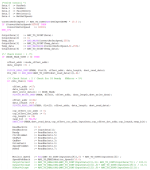Hey everyone, I'm pretty new here, but have been working lightly with AB PLCs for a while now. I've recently hit a stumbling block that I'm hoping someone can shed some light on.
We have a very old machine that we've been slowly upgrading to make more modern. We have a Micro820 controller on it, and we're looking to add some VFDs to 4x motors. I don't have the inputs & outputs available to control all 4x drives with the standard relays & analog signals that I'm used to doing.
I've started trying to understand how to control them over DeviceNet - which I know is possible, but I haven't been able understand it enough to get where I need to.
I really only need to control standard commands, like forward, reverse, speed reference. From all the reading I've done on the 160 drives, none obviously reference CCW code for the 800 controllers (obviously due to the respective age of the two pieces of hardware).
Here's what I think I know:
Explicit messaging is not what I want to use for drive commands and status updates. This is only used for changing parameters that don't have a time-sensitive component to the read/write.
In the manual they talk about configuring the DeviceNet Scanner to be continuously scanning the drive and the PLC and exchanging these commands into variables in the PLC. This is where I'm stumped, because I can't seem to find this mapping function in the CCW.
Should I be looking at Symbolic messaging? Something I don't know about yet?
I've downloaded some sample code from AB which has some UDFB's for the 520 FVDs, and on my testing bench, I have played around with this, and I can actually get the drive to run and stop using that code, and I can see the Actual Speed of the VFD when it's running - so I know it's possible, I just haven't had that ah-ha moment where I understand what to do.
Any pointers would be greatly appreciated.
We have a very old machine that we've been slowly upgrading to make more modern. We have a Micro820 controller on it, and we're looking to add some VFDs to 4x motors. I don't have the inputs & outputs available to control all 4x drives with the standard relays & analog signals that I'm used to doing.
I've started trying to understand how to control them over DeviceNet - which I know is possible, but I haven't been able understand it enough to get where I need to.
I really only need to control standard commands, like forward, reverse, speed reference. From all the reading I've done on the 160 drives, none obviously reference CCW code for the 800 controllers (obviously due to the respective age of the two pieces of hardware).
Here's what I think I know:
Explicit messaging is not what I want to use for drive commands and status updates. This is only used for changing parameters that don't have a time-sensitive component to the read/write.
In the manual they talk about configuring the DeviceNet Scanner to be continuously scanning the drive and the PLC and exchanging these commands into variables in the PLC. This is where I'm stumped, because I can't seem to find this mapping function in the CCW.
Should I be looking at Symbolic messaging? Something I don't know about yet?
I've downloaded some sample code from AB which has some UDFB's for the 520 FVDs, and on my testing bench, I have played around with this, and I can actually get the drive to run and stop using that code, and I can see the Actual Speed of the VFD when it's running - so I know it's possible, I just haven't had that ah-ha moment where I understand what to do.
Any pointers would be greatly appreciated.



